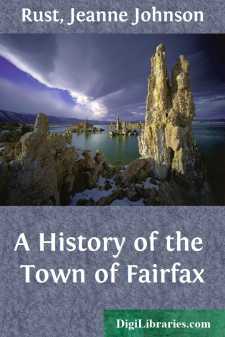Categories
- Antiques & Collectibles 13
- Architecture 36
- Art 48
- Bibles 22
- Biography & Autobiography 813
- Body, Mind & Spirit 142
- Business & Economics 28
- Children's Books 15
- Children's Fiction 12
- Computers 4
- Cooking 94
- Crafts & Hobbies 4
- Drama 346
- Education 46
- Family & Relationships 57
- Fiction 11828
- Games 19
- Gardening 17
- Health & Fitness 34
- History 1377
- House & Home 1
- Humor 147
- Juvenile Fiction 1873
- Juvenile Nonfiction 202
- Language Arts & Disciplines 88
- Law 16
- Literary Collections 686
- Literary Criticism 179
- Mathematics 13
- Medical 41
- Music 40
- Nature 179
- Non-Classifiable 1768
- Performing Arts 7
- Periodicals 1453
- Philosophy 64
- Photography 2
- Poetry 896
- Political Science 203
- Psychology 42
- Reference 154
- Religion 513
- Science 126
- Self-Help 84
- Social Science 81
- Sports & Recreation 34
- Study Aids 3
- Technology & Engineering 59
- Transportation 23
- Travel 463
- True Crime 29
A History of the Town of Fairfax
Description:
Excerpt
A HISTORY OF THE TOWN OF FAIRFAX
When man reaches out into space to explore a new planet, his adventure will be comparable in many ways to that of the colonists who braved the space of water in the early seventeenth century to establish their proprietary rights on a strange continent called "America".
These colonists found themselves confronted with the need to feed, house and clothe themselves with unknown and untried materials reaped from a wilderness which hid their enemy, the red man, and housed the dread mosquito which carried the deadly malaria.
Proof of their danger lies in the history of the Jamestown Colony. Being attacked by red savages upon landing at the malaria infested Jamestown and inexperienced with survival under wilderness conditions, the colonists were reduced to eating their own dead before help finally arrived.
Strengthened in number and sustained by food and help brought by Lord de la Warr, the colonists eventually set up a government, bought peace with their enemy, and settled down to raise tobacco on the land to which they received proprietary rights. Later they expanded their holdings; developed their resources; improved their government; established churches, schools and colleges; gained their independence from their mother country; survived civil strife; and advanced their civilization.
At Jamestown the colonists found that they could not succeed without expanding the Indian's agriculture. They found the savages of the Tidewater section growing corn, muskmelon, pumpkin, watermelon, squash, maypops, gourds and peas in their fertile well-organized gardens. Grapevines were cultivated at the edge of clearings and there were rich harvests of chestnuts, hickory nuts and acorns. Strawberries and other small fruits grew in abundance and mulberry trees stood near every village. Tobacco was grown to itself, in carefully prepared hills arranged in well-organized rows. It developed into a slender plant less than three feet tall and the short, thick leaves, when ripe, were pulled from the stalk and dried before a fire or in the sun. The colonists learned to grow and store the Indian foods for cold winters and they learned to earn their livelihood from the export of the tobacco they grew.
In the northern part of Fairfax County, the Indians grew corn. They fished, mined, and herded buffalo. In order to have sufficient grassland for their "cattle", or buffalo, the Indians deliberately set fire to the forests. They also burned their "old fields" that had once been cultivated for they found that grass grew voluntarily on them if the trees were kept down.
Maxwell in "The Use and Abuse of Forests by Virginia Indians" tells us, "Virginia, between its mountains and the seas was passing through its fiery ordeal and was approaching a crisis at the time the colonists snatched the fagot from the Indian's hand. The tribes were burning everything that would burn and it can be said of the Alleghanies that if the discovery of America had been post-poned five hundred years, Virginia would have been pasture land or desert."
This point is further illustrated by the Manahoac Indian's remark to Captain John Smith that he knew not what lay beyond the Blue Ridge except the sun, "because the woods were not burnt".
Although the settlement by colonists helped to slow down this burning process, it did not stop it altogether. The colonists cleared their land by burning also and when they had exploited one area moved on to another. (They did not burn as large areas as the Indians.) As other freemen came, they pushed upward and inward along the waterways to find unexploited land. This, of course, hastened the development of the Fairfax County area but it left acres of "old fields" going idle for want of a little fertilizer. Many ignorant overseers of large land holdings knew little of fertilization or replenishing the soil and they too, when they had exhausted one part of the proprietorship, moved on to another, which they cleared by burning. They gathered slaves from other plantations to help fell the trees and at night large groups of negroes gathered round the mound of burning trees and raised their voices in the spiritual singing that was characteristic of them. Sometimes the burning lasted for two or three days and laughter, song and wine were plentiful....


